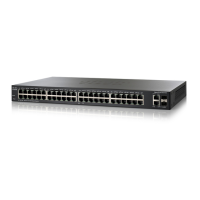14
Cisco Small Business 200 1.1 Series Smart Switch Administration Guide 190
Managing MAC Address Tables
MAC addresses are stored in the Static Address table or the Dynamic Address
table, along with VLAN and port information. Static addresses are configured by
the user in the Static Address table and do not age out. MAC addresses seen in
packets arriving at the switch are listed in the Dynamic Address table for a period
of time. If another frame with the same source MAC address does not appear on
the switch before that time expires, the entry is deleted from the table.
When a frame arrives on the switch, the switch searches for a MAC address that
matches a static or dynamic table entry. If a match is found, the frame is marked for
egress on a specific port based on the search of the tables. Frames addressed to
a destination MAC address that is not found in the tables are flooded to all the
ports on the relevant VLAN. These frames are called Unknown Unicast Frames.
The switch supports a maximum of 8,000 static and dynamic MAC addresses.
This section contains information for defining both static and dynamic MAC
address tables and includes the following topics:
• Configuring Static MAC Addresses
• Dynamic MAC Addresses
Configuring Static MAC Addresses
Static addresses can be assigned to a specific interface and VLAN on the switch.
The addresses are bound to the assigned interface. If a static address is seen on
another interface, the address is ignored and it is not written to the address table.
The
Static Addresses
page
enables
viewing statically-configured MAC addresses
and creating new static MAC addresses.

